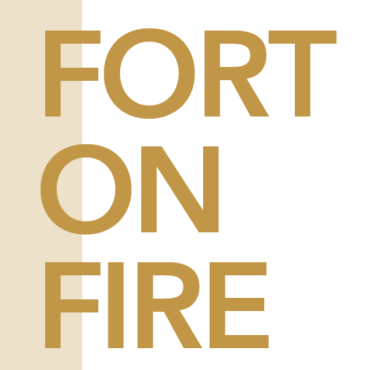
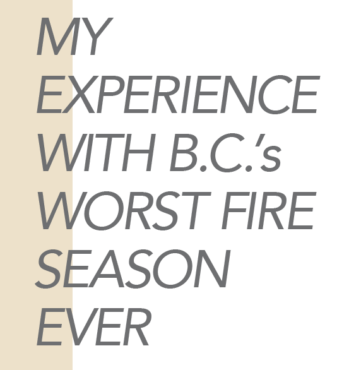
In August 2018, the Shovel Lake fire threatened my hometown of Fort St. James, B.C. My town always felt removed from the province; it’s a small northern community that often seems forgotten. It’s the last place I ever thought would be threatened by disaster.
The following is my experience during that time.
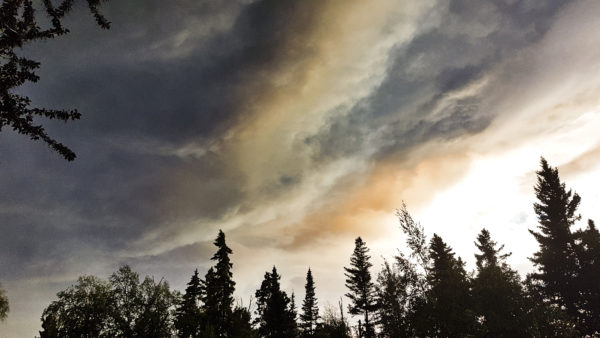
Photos by Blaine Willick, Contributing Writer.
Aug. 12
It was Sunday. I was relaxed, and my roommate and I were watching TV. In a few days I would be travelling home for a wedding and to spend time with family and friends. I was not worried about anything in particular.
Then I got the call. My mother told me that the wind had changed, and that the Shovel Lake fire had grown to monstrous proportions: in a two day period it had grown from 5 000 hectares to 20 000. I rescheduled my flight, packed my bag, and within an hour I was at the airport.
During the time when I was in the air and couldn’t do anything but wait, I felt anxiety begin to fester inside of me. I held my breath as the plane soared away from calm blue skies into a thick fog of smoke, desperately trying to retain a bit of fresh air.
As my mother and I drove into town from the airport, the smoke got thicker. To add to the apocalyptic atmosphere, the sun had disappeared behind a curtain of black smoke. This was not the homecoming I had expected.
Aug. 13
The town was on evacuation alert and the entire community was packing their belongings, preparing for the worst. This was a difficult day as my mother and I packed up our house. Everyone in the community was ready to leave. The Shovel Lake fire continued to grow until it was the size of Vancouver. On this particular day, the fire was about 26 kilometers from town.
My father and uncle own a logging outfit in Fort St. James called Newland Enterprises Ltd., and most of their employees — people I’ve known all my life — were helping to combat the blaze. While others were frantically packing up everything they owned, one of the Newland employees became trapped by fire. He was in a machine clearing an area to help control the blaze, but unfortunately for him, a forestry worker was panicking and stopped communicating with anyone. Without informing any of the crew, the forestry worker began “back-burning” — a firefighting technique wherein a small, controlled fire is started in order to burn trees that are in the path of a forest fire. That way, once a fire arrives, there is no fuel left for it to continue burning, and it burns out (hopefully). Fire from the back-burning soon surrounded the Newland employee, and he had to drive into a swamp to escape the blaze. Water bombers eventually flew in and were able to clear a path to safety. Luckily the operator made it out unscathed.
The only thing that spread faster than the wildfire that day were the rumours about the fire. For several days, the loggers of Fort had been busy clearing timber from the fire’s path, cutting fireguards (strips of forest cut to help prevent fire from spreading), and assisting firefighters in any way they could. One person saw a photo and started assuming that the fire was a lot closer than it actually was and started posting about it online. That post was all it took to make some people panic, leave the frontlines, and rush home to evacuate their families. After the incident was over and people realized what had happened, the community became more critical of reckless social media activity, and relied more on official news releases.
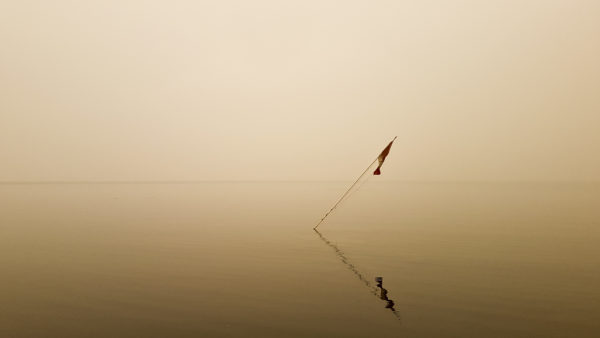
Aug. 14
I helped my grandfather pack up his workshop into a trailer. In this shop he crafted beautiful tables, creative crib boards, and even rebuilt an Oldsmobile Cutlass Supreme by himself. There was a lot of history beneath the sawdust in his shop; each item left a vacant shadow in the dust as it was packed into the trailer. It was a sobering moment when my grandfather rested on a stool and gazed at his workplace. If the worst occurred, the only thing that would remain of his shop would be memories.
Another fire — the Hat Lake fire — burned to the north of us. It was not as close as the Shovel Lake fire, but it still weighed on our minds. That evening, we watched a video one of my cousins had taken of three water bombers flying in a straight-line formation overhead, one right after the other, dropping massive amounts of water onto a smoldering pile of trees at the edge of a fireguard. The planes were so low that they skimmed the treetops.
This was the day my vacation was originally supposed to have started.
Aug. 15
I went into the Newland office. I wanted to help out, even if there wasn’t much I could do. The menial tasks helped to clear my mind. I packed hoses, prepped generators, and gathered supplies that would be sent out to the crews.
My cousin and I went to a friend’s house to help move freezers brimming with food. Afterwards we rested outside on a bench and the world just seemed to fade away into the grey haze that surrounded us. Normally clearly visible, the neighbouring houses had disappeared, and there was an eerie silence. No birds, no breeze, no people. It was like being adrift at sea, with only the bench keeping us from drowning in the shady depths.
My grandparents left Fort for cleaner air, heading about 3 hours northeast to my aunt’s place in Mackenzie. The seniors of the community were greatly affected by the smoke, and many of them had to wear face masks to help filter the air. The local Indigenous band, the Nak’azdli, had worked tirelessly to evacuate the elders of not only our town, but of the even smaller surrounding communities.
Later in the day, my mother and I drove from Fort to Prince George to take our possessions to a friend’s place. She towed a trailer with our keepsakes — I drove my grandfather’s Oldsmobile. We didn’t want to lose his priceless antique car that he’d poured countless of hours into. My too-short drive in the Oldsmobile was incredible, and for a brief time I forgot about the fire.
On the way back, we passed through the neighbouring town of Vanderhoof. There were three large hay sheds on the outskirts of town and when we passed by, one of them was ablaze. This fire was man made — some imbecile wanted to damage the goods of his competition during the driest part of the year. Luckily, firefighters got there in time and stopped the fire from spreading.
Aug. 16
Pumps were set up along the most vulnerable community roads where every twenty metres, a towering sprinkler was erected. If the fire advanced toward these sprinklers, they would drench the surrounding area. The connecting hoses crossed our driveway, and every day I would slowly drive over them, terrified I might damage one.
A few community members noticed that the firefighters and pump operators were stationed in our hockey rink. In total, about 80 fighters slept on the rink’s concrete floor and ate rationed meals. The community did not feel this was appropriate, and some volunteers began to organize ways to assist the firefighters and make them more comfortable.
Each evening there was a community meeting hosted by the police where members were given updates and information. At this particular meeting, the police were recommending that some community members leave town before the official order was given as this would avoid one large, chaotic evacuation.
That evening, my family and I set up a pump and spread sprinklers around our yard. After we had finished dampening the property, we invited some friends and family over. Things had been so stressful that everyone needed a break. We ate, drank, and had a comforting evening as plumes of smoke circled above us. Who knew that you could have fun when it seemed like the world was ending?
Aug. 17
Following the police’s recommendation at the town hall meeting the night before, it didn’t take long until the town emptied. Many headed to Prince George to stay in hotels or with family.
Fort St. James is situated on the enormous Stuart Lake, and occasionally the wind from the lake would blow into the town. During these moments, the smoke would vanish. To anyone who hadn’t lived through the last few days it would seem like a beautiful summer day, except for the fact that the place was deserted. Eventually, when the wind stopped blowing, that momentary reprieve would disappear again and the smoke would settle back in.
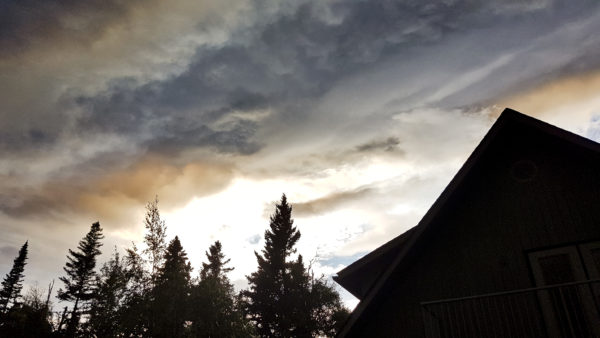
This was the first evening that volunteers from the community prepared dinner for the firefighters, and it was to be the first of many.
Aug. 18
My mother and I drove a truckload of donated water and Gatorade out to the distant fire hall. We passed kilometres of hoses and sprinklers. The pump crews were filling mounds of sandbags and were elated to have some refreshing drinks as they laboured. While unloading the donations, I was able to look at the equipment. The yard was full of coiled hoses the size of cars, and pumps as large as camping trailers. The pump operators were kind and hardworking. If the worst was to come, the town’s defense was in good hands.
The volunteers were now working together to feed those protecting our hometown. They set up shop in our curling rink and turned it into a mess hall. They were up at 3 a.m. to prepare breakfast, and feeding firefighters by 4:30 a.m. They made sandwiches for lunch, and prepared dinner each day. There were about 25 people making the meals, and plenty more donating food they had made at home. They also set up a billeting program, so firefighters who remained in town could sleep in a bed instead of on the concrete floor of the hockey rink.
Aug. 19
My dad and I were recruited by the volunteers to cook pork chops for the firefighters. Between the two of us, we cooked about 80 pork chops in an hour. The volunteers had been doing their best to keep the firefighters fed well, and had made hearty dinners consisting of pork chops, stews, prime rib roast, pasta, and even a massive turkey dinner. Even some of the RCMP officers started attending the dinners since the home cooked meals were better than the food they were being supplied. Some of the firefighters told us that they had never seen a group come together and support them like the community of Fort St. James.
The wedding that I had originally planned to return home for still went ahead. The couple had to move the ceremony to a neighbouring town, which meant they were scrambling to reorganize everything on the fly. Even with all the challenges, it was still a beautiful wedding. It was touching to see such resilience from a couple who refused to let a natural disaster dictate their lives.
Aug. 20
I left town to return to Victoria and felt a little more at ease. The wind direction looked good, and was pushing the fire away from the town. I felt better knowing my family was safe and my community was being protected.
A few days later the firefighters and others would leave Fort. The situation had improved to the point that residents started returning to town. The pandemonium had subsided. It wasn’t until things slowed down that people realized how fortunate we had been — when the fire finally died down, it had been less than ten kilometres away from populated areas.
British Columbia had approximately 600 fires this summer and burned 12 985 square kilometres of land, making 2018 the worst wildfire season the province has ever had, followed shortly by 2017.. Five of the ten worst wildfire seasons in B.C. have occurred since 2010. Thousands of people are affected each year, and without the communities who come together to provide aid and support, the devastation could be much greater.
I want to end this story with a thanks to all those who stayed and helped. To the Nak’azdli Band that helped to evacuate the remote communities around Fort. To the people that opened their homes to strangers. To the volunteers that stayed to feed those who fought. To the police that ensured everyone evacuated safely. And of course, the biggest thanks go out to the firefighters, pump operators, water bombers, and many more who risked their lives to keep communities like Fort St. James safe.








